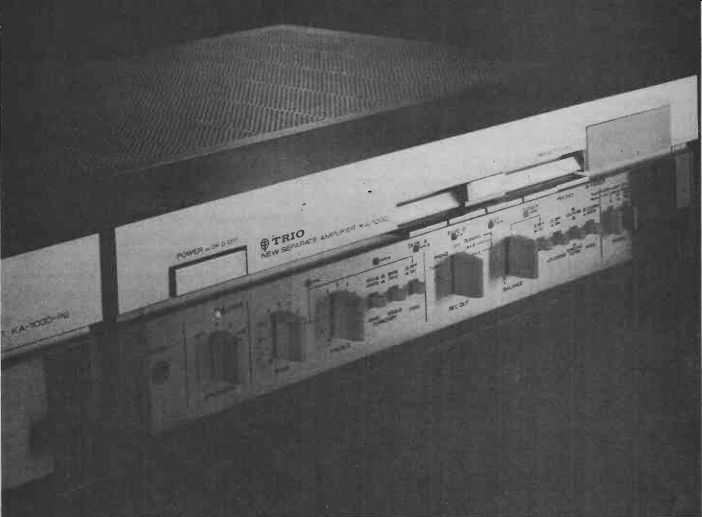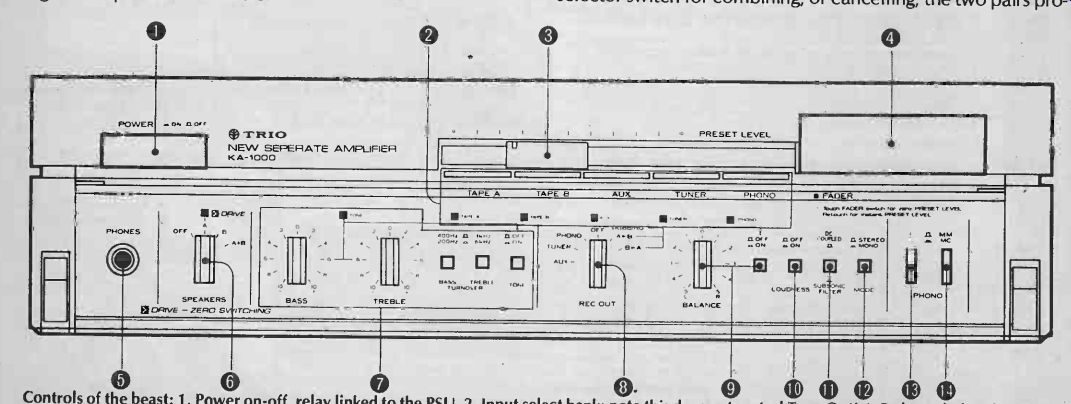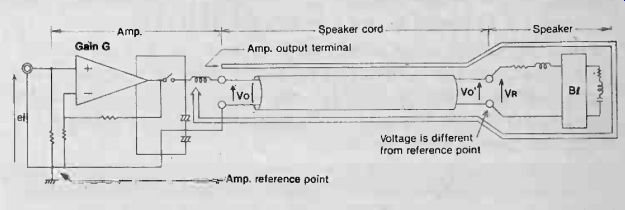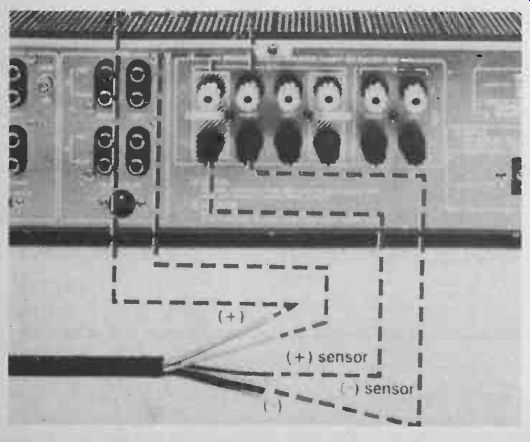
This month Ron (Sherlock) Harris discovers that the Trio Sigma-Drive is not something you build into a spaceship; and reveals the Mystery of the Missing Letters. Read on, gentle reader…
One of the latest ideas to attempt to raise the height of hi-fi is that of Sigma-Drive. It is the brainchild of Trio, who have an enviable reputation for amplifier design anyway. They now have a range of models incorporating the new panacea and I'm taking a look at the most powerful of these this month, the KA-1000, which boasts some 100W per channel, separate PSU and a recording facility which will delight the tape enthusiast.
Total Sum Drive?
As any mathematician worth his slide-rule will tell you, 'Sigma' means 'total sum of', (but for no reason other than that it is the definition assigned to it by mathematicians.) The principle of Sigma-Drive is thus to take into account the total load presented to the amplifier and to use this to control the circuitry such that the loudspeaker accurately follows the signal input.
Trio's own literature is somewhat confusing, making much ado about feedback, back-EMF, speaker wires, non-magnetic designs etc. etc.--and totally clouding the issue! As far as I can see what Sigma-Drive actually does is to extend the feedback loop of the amplifier to include a voltage derived from the speaker terminals. This is then used as an error-correction signal to alter the drive from the output stage to the speaker. In practice this will raise the damping factor of the amp significantly, since the output appears to be a constant-voltage source, ie zero-impedance. But as nothing in life is perfect --I dare say even Stevie Nicks has off-days --the output impedance appears to be extremely low, rather than actually zero. The measured damping factor of the KA-1000 is somewhere between 1500-2000, even at low frequencies.
This in turn means that the effect of the cables connecting amp and speaker is drastically reduced, even eliminated. Super-cables are thus rendered superfluous, as the amplifier is correcting the output after the cable! The logical extension of all this must be a tri-amp system using Sigma-Drive such that the control is applied to the voice-coil itself.
In this manner all external influence would, in theory, be corrected by the amplifier. Any plans Trio?
Non-Magnetic What?
The KA 1000 also boasts a 'non-magnetic' PSU design to minimize the distortion which Trio say is induced into circuits by the proximity of magnetic current carrying materials. The power amp is designed to also have an exceptionally wide open-loop response, such that it is highly stable and has a fast rise-time.
As you can see from the diagram, the preamp section is well endowed with facilities; most of which hide beneath a very attractive smoked glass flap when not required. LED indication is also provided, in case you're not exactly sure what you've just pressed, presumably.
The volume control is a little unusual in its operation. For a start it is a horizontal slider and is labeled 'pre-set' level. Next to it is a comparatively huge rectangle, which glows with a blue light, marked 'fader'. Apparently, you are supposed to set the level you want with the 'pre-set level' and then touch the fader to drop this to zero--for changing inputs, records, etc. Touching the fader again restores the pre-set level--hence the name.
In practice, I'm afraid I found the slider stiff and awkward and would have preferred a nice normal rotary. (I'm just an old-fashioned city-boy really!) The fader is a neat idea, and is easier to operate that the usual '-20 dB' mute switches which abound on Eastern fascias.

above: Controls of the beast: 1. Power on-off, relay linked into the PSU. 2. Input select bank: note this does not control Tape Out. Faders with: takes the volume down to zero (and back) at a touch. Handy for changing records, etc. 3. Preset Level: a volume control in disguise. 5. Phones: about the only standard thing on the unit! 6. Speaker select: note that Sigma-Drive is only available on A. 7. Tone: can be switched for turnover-and out completely. 8. Record out: sets the input which controls the Tape Output. Independent, so you can play a record and record from the radio! 9. Balance: switchable out would you believe? 10. Loudness. 11. Subsonic Filter. 12. Stereo switch. 13/14. Phono input select and MC/MM gain select.
Control Tones
Sigma-Drive is only available on the main speakers and the selector switch for combining, or cancelling, the two pairs provided for will thus act as a comparator --should you want to see what difference Sigma-Drive actually makes.
Tone control turnover frequency is variable and the whole circuit can be switched out, as can the balance control (!) for 'straight-wire-with-gain' freaks.
Tape facilities allow you to record from one source while listening to another and dubbing in either direction between two tape decks is provided for.
The PSU has no controls on it at all, being operated by the mains switch on the front panel of the KA 1000 itself.

Above: how the speaker and feedback are arranged in a normal amplifier.
Note that due to the voltage drop down the cable, the damping factor is
reduced at the speaker terminals from the value it had at the amp terminals.

Above: how Sigma-Drive overcomes the problem, fitting the speaker into
the feedback loop with the use of the sensor terminals. Four wires to
the loudspeaker are now required.
Test Drive Time
The Trio did well under test, as you'd expect, and gets ten out of ten for engineering. The distortion measurements are well-nigh all noise and, as a simple amplifier, it is difficult to fault the KA 1000. I could not duplicate Trio's figures for S/N on the phono input though, but 76 dB weighted is a good figure nonetheless. I also found this input a little insensitive and it took some driving in moving-magnet mode to obtain full power (around 4 mV in fact). The moving coil input returned figures of 66 dB for noise and sensitivity of about 200 uV (for 100R). Almost exactly to spec and good results in themselves.
Peak power delivery into 8R proved to be in order of 170 W with an incredible slew-rate of 140 V/us! Checking the frequency response confirmed the rise time measurement, as the amp is flat to around 300 kHz! Table 1 gives a run down of the rest of the specs and will interest the mathematically-minded.
Enter The Drag
With this amplifier you wouldn't be moving the hi-fi around too much. There are four wires to each speaker and, although Trio provide a 'Sigma-Cable' with these already in, it wasn't in the box when I received it. It would probably be too short anyway according to Murphy's Third Law of Installation, so I wasn't that upset.
Adding more leads to the set-up is about as much fun as a toothache on Sunday afternoon, and just as welcome. All through the leaflet Trio terrify the buyer with the consequences of connecting the Sigma-Drive terminals incorrectly and by the time I'd finished I was feeling quite nervous myself! (A large brandy was thus justified ... ). Thankfully all was well and the amp clicked into operation first time. I was surprised at how distinctive a sound this amplifier has. It is clean, sharp, and very fast. You notice it first on bass guitar or drum sounds. The output simply gets from nothing to music quicker and more realistically. Undoubtedly the best Eastern amp I've heard.
Some may find it a little cold, I think, as it is most unforgiving of program faults, or inferior equipment coupled to it! Most of my tests were conducted with my beloved Thorens 1605/SME III and Dynavector Karat at one end and KEF 105 II's at the other.
For a time I substituted Shure's new MV-30HE pickup, designed for the SME III, but I found the output was too low to drive the Trio successfully.
Conclusions?
The only conceivable conclusion I can come to is that Sigma-Drive works. Switching it out produces a 'looser' bass sound altogether and the detail disappears to a large extent, as the f regency response appears to roughen up considerably.
This makes it unlikely that people using a KA 1000 would connect two sets of loudspeakers--I know I wouldn't--as the difference in sound quality is very marked. With the Sigma-Drive 'on', the Trio is a fine sounding machine and one which is well worth the asking price for the engineering which has gone into it, and the sound quality it delivers.

---- How all those wires fit on to a loudspeaker. Confusing isn't it?

-------Above: the frequency vs distortion characteristics of a normal
low amp into eight ohms, 20 Hz -20 kHz. Measured at the amp. out terminals.

---- Above: the effect of the above, using Sigma-Drive and normal drive
methods. Flatter is it not? All effects of the cables have been removed
totally.

Accessory To Revelation!
Some months ago, I told the tale of our horrendous experience with the products of a well-known accessory company, without actually naming the firm concerned until such time as I'd received a reply from them to my irate epistles.
Apparently, they had never received my correspondence at all, only becoming aware of the fuss when a little man strolled up to their exhibition stand armed with a copy of ETI! (Even though I never mentioned the name QED, most people had sussed out who it was I was raving about.) The MD rang me up immediately after the exhibition, and I have since received this letter expounding their side of the case: To: Electronics Today International, Argus Specialist Publications Ltd.
--------
Dear Mr. Harris,
Further to our recent telephone conversation, and the subsequent receipt of your 'Audiophile' article, I would like to confirm that prior to the exhibition 'rumor' we were totally unaware that you were trying to contact us. I can assure you that all letters received by us are answered (including the ones asking for spare parts for wasting machines etc.). Having established contact, however, I am at a loss to explain how the three products referred to in your article passed our inspection. Normally, each product is individually tested and such faults should be spotted. My only defense is that these must be isolated incidents because otherwise we would have been literally flooded with complaints and this has not occurred.
We estimate that the three products were probably manufactured at the end of last year. Since that time we have introduced a complete new range of electronic test gear to make it easier for our staff to identify such faults and all products now carry the initials of the inspector.
In addition, I am pleased to confirm that all QED 3-way speaker switching units are now internally wired with QED 42-strand cable.
Finally, I would like to thank the reader of your magazine who informed us of the Audiophile' article because he, more than anybody else, is a testimony to QED's reputation for both quality products and business integrity. As a user of several QED products, he felt that we should have the opportunity to 'clear our name'. Assuring you of our best intentions at all times.
Yours sincerely
-Bob Abraham
QED Audio Products
-------------
Kenwood/Trio KA-1000 Amplifier
Power Output (8 ohm load, 1 kHz) :103 W Power Bandwidth (100 W) : 3 Hz -320 kHz THD at 100 W output : 0.008% Intermodulation Distortion (100 W) : 0.1 % Rise Time : 140 V/us
Peak Power Delivery (8 ohm) :172 W S/N ratios (weighted) -moving magnet : 76 dB (sen. 4 mV) moving coil : 66 dB (sen. 200 uV) tape/aux/tuner inputs :100 dB (sen. 150 mV)
Dimensions--Main amp : 440 x 123 x 375 mm
PSU: 140x 123 x 358 mm
Typical Price : £530 (ca. 1982. Mult. by 1.5 for $USD)
= = = =
Electronics Today (UK print magazine)
Also see: